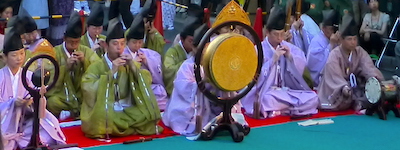As mentioned in previous posts, I have been reading Haruki Murakami’s 1Q84 in Japanese (very slowly). After reading some reviews I wrote a blog post on why some of the characters frequently repeat one another, something critics didn’t like. Another thing several critics didn’t like is the Little People saying “Ho ho”.
So let’s have a look at this “Ho ho”. But first, in case you didn’t read the book, a quick setting of the scene may help.
Air Chrysalys
In 1Q84, there is a “book in the book” called “Air Chrysalys” (kuukisanagi, 空気さなぎ). This book is a kind of fairytale told from the perspective of a ten-year-old girl who lives in a rural commune. As punishment for letting an old mountain goat die, she gets locked up in a shed with the dead goat for a period of ten days*.
One night, the “Little People”** appear from the mouth of the dead goat. This scene starts with one of my favourite descriptions in the Japanese text:
あたりが暗くなると、死んだ山羊の目が星明かりを受けてきらりと光った。
atari ga kuraku naru to, shinda yagi no me ga hoshiakari wo ukete kirari to hikatta.
In the English translation by Jay Rubin, this reads:
When darkness falls, the dead goat’s eye sparkles in the starlight.
The Japanese sentence sparkles a bit more because kirari to means “with a momentary flash of light” and hikatta means shine or glitter.
Murakami puts the reader nicely on the wrong foot, because when six small figures emerge from the goat’s mouth, the little girl thinks “This is like Snow White and the Seven Dwarfs, but there is one missing”. The “Little People” read her thoughts and when she counts again there are seven of them.
Together with the girl they start to make an “air chrysalys” by pulling white threads out of thin air and weaving a kind of cocoon from them. While doing so, they talk to the girl.
“Ho ho,” says the keeper of the beat
The Little People don’t have names or personalities and indeed it is impossible to keep them apart or even describe them in detail, but they have distinct voices. Usually, each of them speaks a short sentence in turn. There is a recurrent pattern where one of them, in translation called the “keeper of the beat”, says “Ho ho”, and the others chorus “Ho ho”:
「ほうほう」はやし役のリトル・ピープルがはやした
「ほうほう」残りの六人が声を合わせた
“houhou” hayashiyaku no RITORU PIIPURU ga hayashita
“houhou” nokori no rokunin ga koe wo awaseta
In the Japanese text, the “keeper of the beat” is called hayashiyaku (はやし役) and calls out houhou (ほうほう). This matters because if this “Ho ho” was merely an interjection or exclamation, it would likely be written hoohoo (ほぉほぉ or ほおほお). So we can assume that houhou has a meaning.
Japanese has many homonyms and this is no exception. There are several possible ways to write houhou, in hiragana or kanji (Chinese characters), each with a different meaning. According to Kotobank, houhou (ほうほう) means
① 物を投げたりたたいたりする音、またはそのさまを表わす語。ぽんぽん。
“The sound of repeatedly throwing or striking something, or a word to representing it”
One of the kanji writings of houhou (ほうほう) is 彭々), which makes the meaning more clear because the character 彭 means “the sound of a drum”.
Because Murakami wrote the word in hiragana, we can’t be entirely sure, but the meanings of the other kanji writings (這々 perplexity, 方法 method) do not make much sense in the given context.
The link with Noh theatre
One of the Little People, who Murakami calls the hayashiyaku, calls out “Ho ho”, and the other six echo this in chorus. The translator of the book, the great Jay Rubin, translates hayashiyaku as “keeper of the beat” to reflect the meaning of houhou as drum beat, and also because Murakami uses the verb hayasu which literally means “to keep time”. So “says the keeper of the beat” is a very nice way to translate this.
But the literal meaning in Japanese is “member of a hayashi”, and hayashi (囃子) is the four-piece orchestra in the traditional Noh theatre, consisting of three drummers and a flutist. The task of the drummers is to keep the rhythm (hayasu), but they also use their voices to create drum calls. Another component of Noh is the chorus, usually six to eight people. And finally there are the actors, who unlike in traditional Western theatre do not ony speak their own lines, but can also ‘describe events from the perspective of another character or even a disinterested narrator’.
With this interpretation, Murakami allocates to his seven Little People the roles of actors, chorus and orchestra in a Noh performance, all at the same time, with an audience of one, the little girl. I think this is what lies behind the Little People saying “Ho ho”.
* In Japan, traditionally a month is split in three ten-day periods called jun(旬).
** Murakami calls them リトル・ピープル (RITORU PIIPURU) which is katakana rendition of the English “Little People”. The little girl thinks of them as kobito (小人) which also means “little people”.
